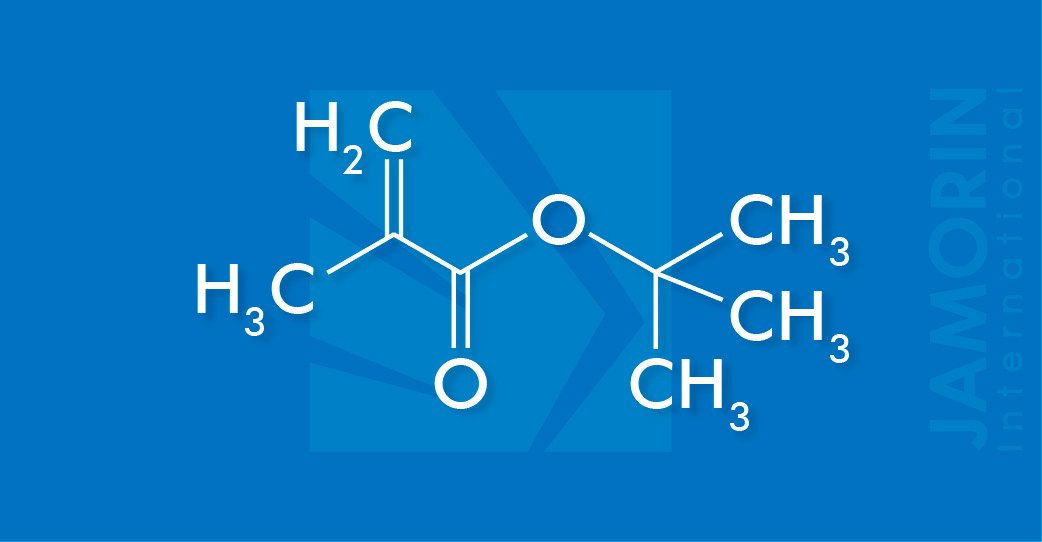C8 H14 O2
min. 99.0%
C8 H14 O2
min. 99.0%
tert-Butyl Methacrylate (TBMA)
tert-Butyl Methacrylate (TBMA) is an ester of Methacrylic acid and is used as a raw material component in the synthesis of polymers. tert-Butyl Methacrylate (TBMA) is a functional monomer consisting of a methacrylate group with a characteristic high reactivity and a cyclic hydrophobic group. tert-Butyl Methacrylate (TBMA) forms homopolymers and copolymers. Copolymers of tert-Butyl Methacrylate (TBMA) can be prepared with (meth)acrylic acid and its salts, amides, and esters, as well as with (meth)acrylates, acrylonitrile, maleic acid esters, vinyl acetate, vinyl chloride, vinylidene chloride, styrene, butadiene, unsaturated polyesters and drying oils, etc.
tert-Butyl Methacrylate (TBMA) is a very useful starting material for chemical syntheses because it readily undergoes addition reactions with a wide variety of organic and inorganic compounds.
Product Type: Methacrylate Monomer
Features & Benefits:
- Hydrophobicity
- Chemical resistance
- Scratch resistance
- Weatherability
- High (Tg) glass transition temperature
- Flame retardancy
- High solids
- Heat resistance
- Hardness
- Adhesion
Characteristics:
- tert-Butyl Methacrylate moiety affords high hydrophobicity close to the polymer backbone.
- High glass transition temperature (Tg 50°C) increases the hardness of polymer.
- Selective heat and chemical resistance allow polymer modification in the processing of the final application.
Applications areas:
- tert-Butyl Methacrylate (TBMA) can be used in emulsion polymerization similar to other well-known acrylates like Butyl Methacrylate or Methylmethacrylate. As the hydrolytic stability under harsh acidic conditions is reduced for tert-Butyl Acrylate (elimination of iso-butylene), it is recommended to use for the polymerization a pH range of 3-4 (controlled via puffer or alkaline substances like ammonia or bicarbonate). With a higher share of tert-Butyl Methacrylate (TBMA) (as a substitute of MMA) in the polymer, we observe an increased tendency of cross-linking. Most probably due to the higher backbone crosslinking tendency of acrylates compared to methacrylates(radical transfer to polymer chain/backbone). Best results concerning particle size distribution were achieved by using a polymer seed, either as a ready polymer dispersion (e.g. polystyrene) or as an in-situ polymer seed.
It is applied in the production of:
- Coatings and Inks
- Plastics
- Personal care
- Adhesives
Chemical Properties:
-
Puritymin. 99.0%
-
Acid Valuemax. 0.1%
-
Water contentmax. 0.05%
-
Color APHAmax. 10
Physical Properties:
-
AppearanceClear, colorless
-
Physical formLiquid
-
Odorn/a
-
Molecular weight142.2 g/mol
-
Polymer Tg117 °C
-
Tg105 °C
-
Density0.875 g/cm3 at 20 °C
-
Boiling Point136 °C
-
Freezing Point– 48 °C
-
Flash pointn/a
-
Melting Point-48 °C
-
Viscosity0.97 mPa · s at 20 °C
-
Vapor Point7.0 mbar at 18.5 °C
-
pHn/a
In order to prevent polymerization, tert-Butyl Methacrylate (TBMA) must always be stored under air, and never under inert gases. The presence of oxygen is required for the stabilizer to function effectively. It has to contain a stabilizer and the storage temperature must not exceed 35 °C. Under these conditions, the storage stability of one year can be expected upon delivery. In order to minimize the likelihood of over storage, the storage procedure should strictly follow the “first-in-first-out” principle. For extended storage periods over 4 weeks, it is advisable to replenish the dissolved oxygen content. The preferred construction material for tanks and pipes is stainless steel. Carbon steel is also acceptable, although the formation of rust may be a problem with product quality (color). Iron(III)-ions have been shown to be a weak polymerization initiator. If carbon steel is to be used, special procedures should be used to prepare the tank for use. Storage tanks, pumps, and pipes should be earthed.
Storage & Handling:
In order to prevent polymerization, tert-Butyl Methacrylate (TBMA) must always be stored under air, and never under inert gases. The presence of oxygen is required for the stabilizer to function effectively. It has to contain a stabilizer and the storage temperature must not exceed 35 °C. Under these conditions, the storage stability of one year can be expected upon delivery. In order to minimize the likelihood of over storage, the storage procedure should strictly follow the “first-in-first-out” principle. For extended storage periods over 4 weeks, it is advisable to replenish the dissolved oxygen content. The preferred construction material for tanks and pipes is stainless steel. Carbon steel is also acceptable, although the formation of rust may be a problem with product quality (color). Iron(III)-ions have been shown to be a weak polymerization initiator. If carbon steel is to be used, special procedures should be used to prepare the tank for use. Storage tanks, pumps, and pipes should be earthed.
A Safety Data Sheet has been compiled for tert-Butyl Methacrylate (TBMA) that contains up-to-date information on questions relevant to safety.
The data contained in this publication are based on our current knowledge and experience. In view of the many factors that may affect the processing and application of our product, these data do not relieve processors from carrying out their own investigations and tests; neither do these data imply any guarantee of certain properties, nor the suitability of the product for a specific purpose. Any descriptions, drawings, photographs, data, proportions, weights, etc. given herein may change without prior information and do not constitute the agreed contractual quality of the product. It is the responsibility of the recipient of our products to ensure that any proprietary rights and existing laws and legislation are observed.
